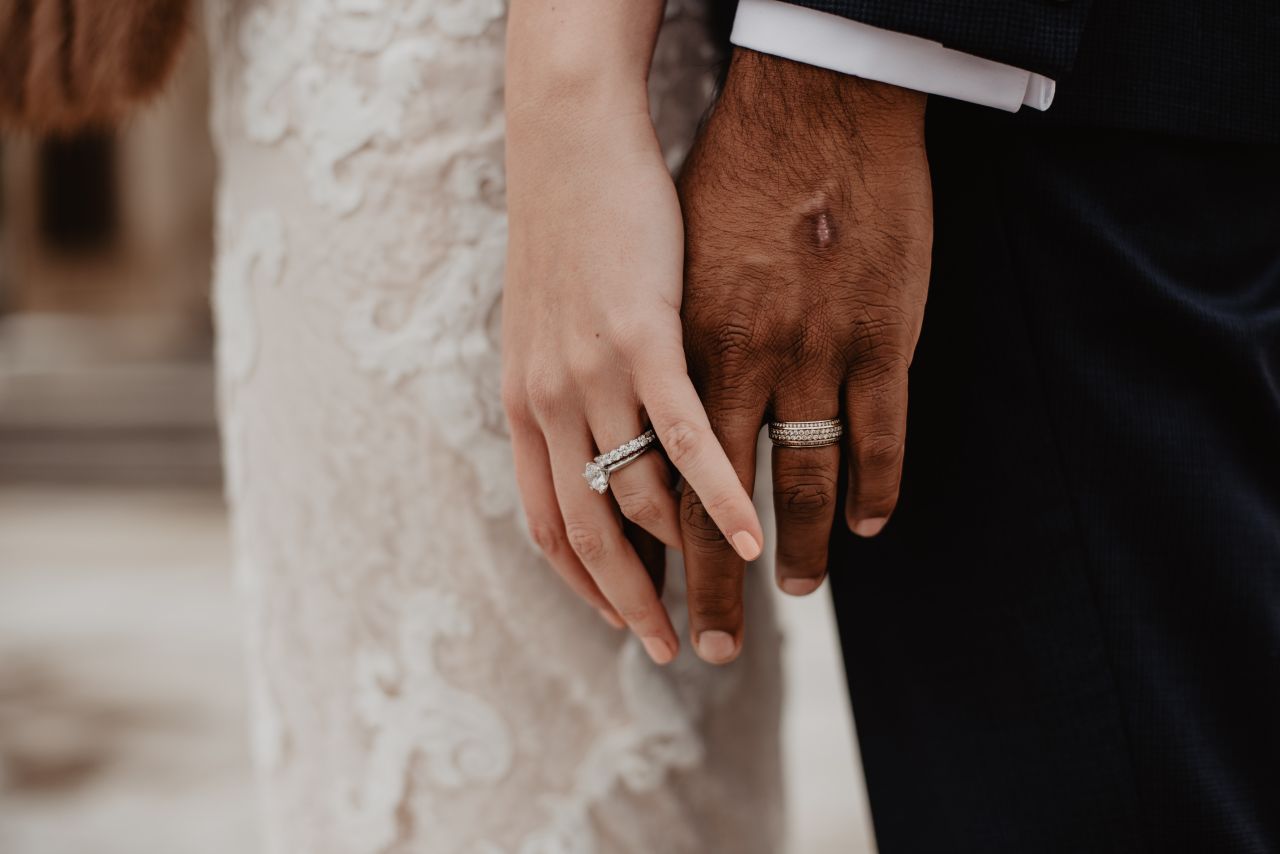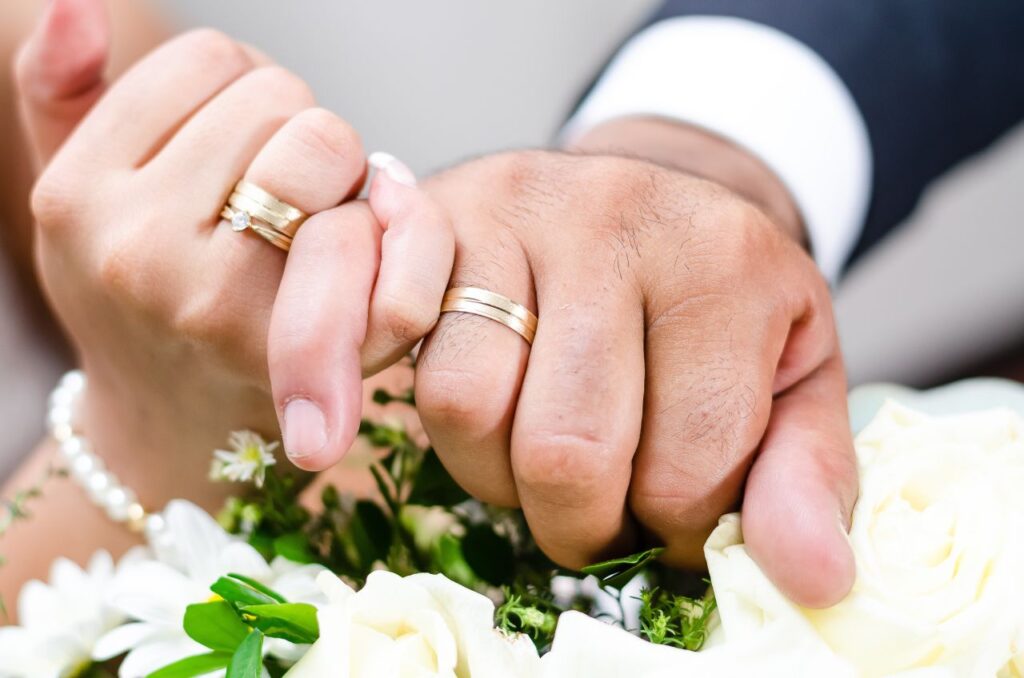Choosing the right wedding band size can be challenging, especially since no ring guarantees a perfect fit every day. A well-fitting wedding band is one you can wear comfortably, with minimal adjustments needed throughout the day.
For many, a wedding band is the first piece of jewellery they wear daily, symbolising a lifelong commitment. Getting the fit right is essential to keeping your ring in the best condition.
Let’s get straight to the point
Finding the right wedding band fit means balancing comfort and security. A properly sized ring should slide over the knuckle with slight resistance and stay in place without slipping or causing discomfort.
Watch for signs of a too-tight fit (discomfort, difficulty removing) or a too-loose fit (spinning, slipping off). Consult a jeweller for accurate sizing, consider factors like bandwidth and finger shape, and test the fit during everyday activities.
Remember that finger size fluctuates with temperature, weight, and activity, so a mid-day measurement offers the best accuracy. Seasonal changes may affect fit, so only resize if discomfort or slipping is constant.
What Is the Ideal Ring Size?

The ideal wedding band size will fit snugly enough to stay securely in place but should still slide over your knuckles with some effort. Women’s ring sizes generally range between 5 and 8, though this may vary based on knuckle size and finger shape. When properly sized, the ring should:
- Slide over your knuckle with slight resistance
- Stay in place without slipping off
- Require minor effort to remove
A slight adjustment—often a half or quarter size larger than your exact finger measurement—can create a comfortable, secure fit.
Signs of a Too-Tight Fit
Sometimes, it’s immediately obvious when a ring is too tight. Other times, subtle signs indicate an ill fit. Here are some signs that a ring may be too small:
- Discomfort and Tingling: If the ring causes throbbing, tingling, or pain, it’s likely too tight.
- Difficulty Removing: Needing soap or lotion to remove the ring may indicate a smaller size is necessary.
- Finger Discoloration or Indentation: Redness or indentations around the ring area show that the size is too small.
- Finger Swelling: Excess skin around the band can cause a “muffin top” effect, which may mean increasing the ring size is time.
Recognising a Too-Loose Fit
If a wedding band is too big, it can easily slip off, increasing the risk of losing it. Here’s how to recognise when a ring is too loose:
- Rotating on Your Finger: If the ring frequently spins, it’s a sign it may need resizing.
- Slipping Off When Your Hand Drops: A ring that easily falls off when you lower your hand is likely too big.
- No Resistance When Removing: Ideally, you should feel some resistance when taking off a well-fitting ring. If it slips off too easily, resizing may be necessary.
How to Find the Perfect Ring Size
Choosing the right wedding band size involves more than measuring your finger. Here’s how to ensure a comfortable, secure fit:
Listen to Your Comfort Level
Pay attention to how the ring feels throughout the day. Does it stay in place? Does it feel tight in the morning and looser in the evening? Answering these questions can help you assess if you have the correct size.
Consult a Jeweller
Professional jewellers use various tools to measure your finger accurately. Visiting a jeweller is especially important if you’re resizing an engagement or wedding band since certain metals or diamond settings may require specific adjustments.
Test with Real-Life Movements
Try wearing it while performing daily tasks to get a true feel for the ring’s fit. Move your fingers, lift your hands above your head, or pretend to type. A well-sized ring should stay comfortably in place without restricting movement.
Fitting Tips for Different Finger Shapes
The fit of your ring will vary depending on the shape and structure of your fingers. Here’s how to choose the best fit for different finger types:
Wide Fingers with Small Knuckles
If your fingers are broad with no distinct knuckles, choose a ring size that fits closely. Test the fit with various hand motions to ensure it is comfortable and secure.
Large Knuckles with Thin Fingers
For fingers with larger knuckles and thinner bases, select a ring size that comfortably slides over the knuckle but stays secure on the finger. A jeweller can add “sizing beads” or “speed bumps” inside the ring to balance the fit, especially if the ring tends to spin.
Tips for Maintaining a Comfortable Fit
Achieving a comfortable ring fit is crucial for long-term wear. Your ring should be snug enough to prevent slipping but loose enough to allow for natural finger movement. Here are some tips for finding a comfortable fit:
- Measure at Midday: Finger size can fluctuate throughout the day. When swelling is at its peak, measuring in the afternoon gives the most accurate sizing.
- Consider Band Width: Wider bands fit more tightly, so consider this when selecting the right size. For a better fit, try a ring sizer close in width to your chosen ring
Factors That Can Affect Ring Fit
Your ring size may change over time due to various factors. Understanding these can help you prepare for adjustments if necessary:
- Temperature Fluctuations: Cold weather causes fingers to shrink, while heat makes them swell. Choose a size that balances these seasonal changes.
- Pregnancy: Increased blood flow and fluid retention during pregnancy often cause finger swelling.
- Weight Changes: Gaining or losing weight, even slightly, can impact ring size.
- Exercise: Physical activity can cause temporary finger swelling due to increased blood flow.
Achieving the Ideal Fit: A Summary
The perfect ring size accommodates your natural finger fluctuations. Finding a balance is key since neveryfit will remain perfect all day. Here’s a quick guide to finding your best fit:
- Get Professionally Measured: A jeweller’s measurement is more reliable than DIY methods.
- Use a Metal Sizer: Metal ring sizers give a more accurate fit than plastic ones.
- Choose the Right Time: Schedule measurements in the afternoon for the best results.
How to Tell if Your Ring is Too Tight or Loose

Knowing the signs of an ill-fitting ring can help prevent discomfort and loss. Here’s a checklist to gauge if your ring is the correct size:
- Too Tight: Needs lubrication to remove, causes swelling or redness, and leaves marks.
- Too Loose: Spins easily, falls off when the hand is lowered, and can be removed with little effort.
- Just Right: Slides over the knuckle with slight resistance and stays in place comfortably.
Preparing for Seasonal Changes in Ring Fit
You may notice slight changes in how your ring fits throughout the year. Seasonal changes, diet, and activity levels can all influence ring size. Here’s what to remember:
- Summer Fit: Rings may feel tighter during warmer months due to swelling. If this happens, try a larger size or wear the ring on a chain until the swelling subsides.
- Winter Fit: Rings may feel looser in cooler weather. If your ring slips off easily in winter, consider wearing a temporary ring guard or adjusting the size.
Deciding on Resizing: When to Act
If you’re unsure whether to resize, waiting for a change in season can help you gauge if your ring size needs adjustment. Here’s when resizing may be appropriate:
- Consistent Discomfort: Resizing may be necessary if your ring causes frequent discomfort.
- Frequent Slipping: A ring that constantly falls off or needs adjusting is likely too large.
- Seasonal Variability: Consider resizing only if the ring doesn’t fit comfortably for an extended period.
Conclusion
A well-fitting wedding band balances comfort with security. The ideal fit lets your ring slide over the knuckle with slight resistance while staying securely in place.
Remember that finger size fluctuates due to factors like temperature, diet, and activity, so choosing a comfortable ring is key.
Consulting a professional jeweller and testing your ring during everyday activities can help you find the perfect fit for a lifetime of wear.
FAQs About Weddings
Rule of Thumb: A proper fitting ring should slide over your knuckle with a little friction and fit snugly on your finger, but not too tight. You should feel resistance and need to apply a little extra force to remove the ring backwards over your knuckle.
An obvious way is to dangle your arms and hands with your fingers pointing toward the floor. If the ring slides right off, the ring is too big. Another indicator is if you have the ring on and it swivels 360 degrees easily when you move your hand; this applies for those who don't have an overly large knuckle.
Truthfully, if you're ever unsure of your ring size, it's always wiser to size up. It's much easier to resize a ring that's too big than it is to resize a ring that's too small, provided the ring can be resized at all.
Before you freak out and run to the jewelry store for a refitting, know that this is entirely normal. Your ring fit will likely change due to environmental factors like weather, aging, and more – it doesn't mean you need to rush to the jewelers for a resizing. Why do our fingers fluctuate in size?
Most people have large knuckles and smaller fingers, which is why a ring can be hard to put on, but once over the knuckle, can feel loose and spin around. If the ring slides too easily over your knuckle, with no resistance, it's too loose and should be resized.

